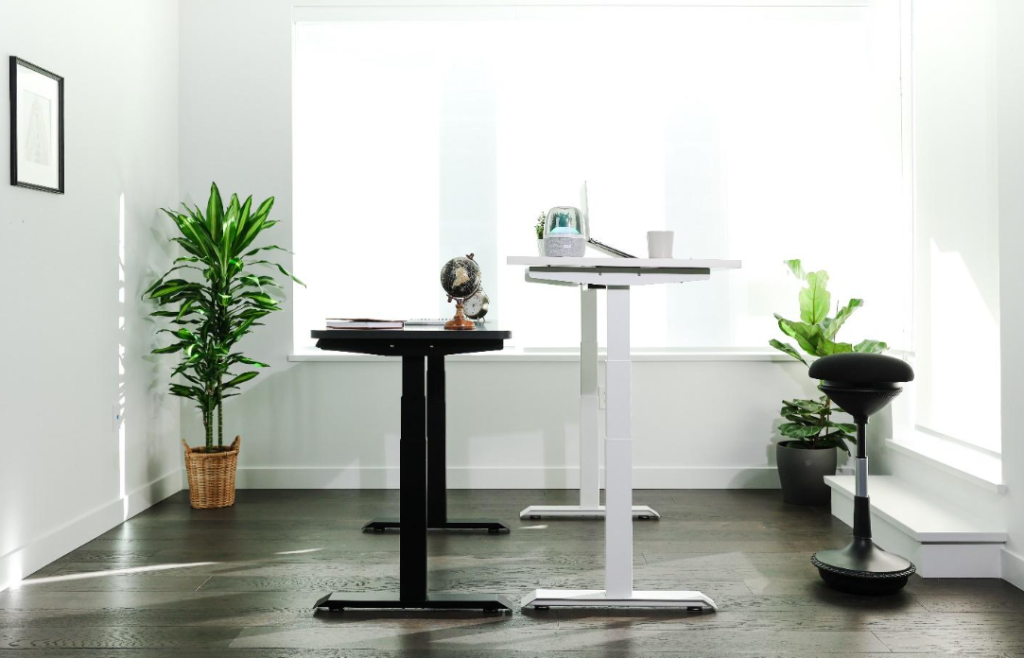Standing desks have gained popularity for their potential health benefits, but it’s crucial to remember that maintaining proper posture is key to reaping those rewards. Poor posture while standing can lead to discomfort, fatigue, and even long-term health issues. In this post, we’ll explore some valuable tips to help you keep your posture correct while using a standing desk.
1. Desk and Monitor Setup
– Monitor at Eye Level: Ensure your computer monitor is at eye level. The top of your screen should be roughly at or just below eye level to prevent neck strain. Use a monitor stand or adjustable arm to achieve the correct height.
– Distance from the Screen: Position your monitor about an arm’s length away from your body to maintain a neutral neck position and reduce eye strain.
2. Desk and Keyboard Height
– Elbow Angle: Adjust your desk height so that your elbows form a roughly 90-degree angle when typing. This ensures that your wrists remain straight and prevents strain.
– Keyboard Placement: Keep your keyboard and mouse at the same level. They should be close enough that you can use them comfortably without reaching too far.
3. Stance and Weight Distribution:
– Even Weight Distribution: Distribute your body weight evenly between both feet. Avoid leaning to one side, as this can lead to muscle imbalances and discomfort.
– Hip Hinge: Stand with your knees slightly bent and your hips in a natural, relaxed position. Avoid locking your knees, which can lead to strain.
4. Footwear:
– Choose Supportive Shoes: Wear comfortable, supportive shoes with good arch support. High heels or flat-soled shoes without adequate support can lead to foot discomfort and posture issues.
– Foot Mat or Footrest: Consider using an anti-fatigue mat or a footrest to reduce pressure on your feet and promote better posture.
5. Movement and Breaks:
– Regular Breaks: Avoid standing in one position for too long. Take short breaks to stretch, walk around, or perform light exercises. These breaks can help reduce fatigue and improve circulation.
6. Mindful Posture:
– Shoulder and Back Alignment: Keep your shoulders relaxed and your back straight. Avoid slouching or rounding your shoulders forward.
– Engage Core Muscles: Gently engage your core muscles to provide support to your spine. This helps maintain a strong and upright posture.
7. Anti-Fatigue Mat:
– Consider an Anti-Fatigue Mat: Standing on a cushioned, anti-fatigue mat can reduce the strain on your legs and lower back, making it more comfortable to stand for extended periods.
8. Ergonomic Accessories:
– Use Ergonomic Accessories: Consider adding ergonomic accessories like a monitor arm, keyboard tray, or a sit-stand desk converter. These can make it easier to customize your setup for better posture.
9. Regular Posture Checks:
– Frequent Self-Assessment: Periodically check your posture and make adjustments as needed. It’s easy to slip into bad habits, so stay vigilant and correct any deviations from proper posture.
Maintaining proper posture at your standing desk is essential for your comfort, productivity, and long-term health. By following these tips and being mindful of your body’s positioning, you can make the most of your standing desk setup and reduce the risk of discomfort and posture-related issues. Remember that good posture is a habit that takes practice, so be patient with yourself as you make these adjustments and enjoy the benefits of a healthier work environment.



